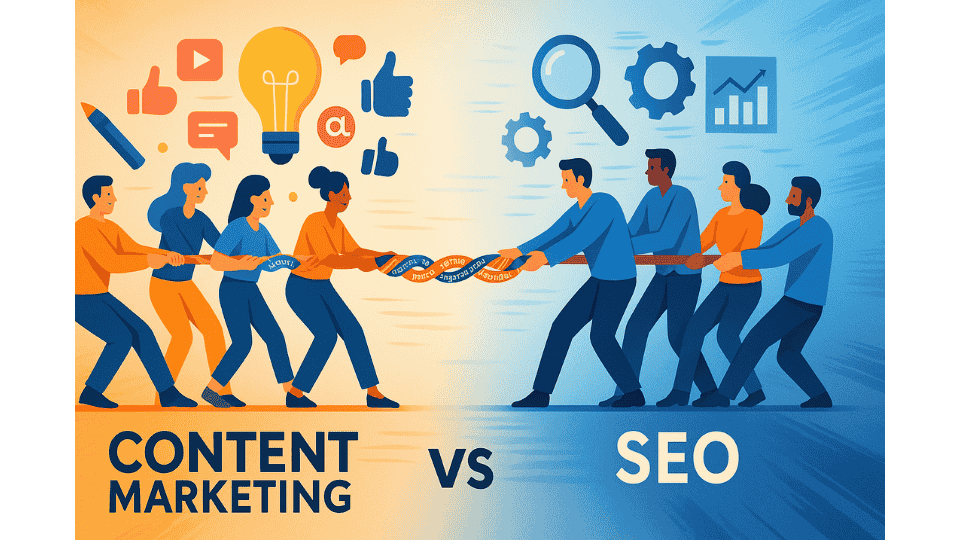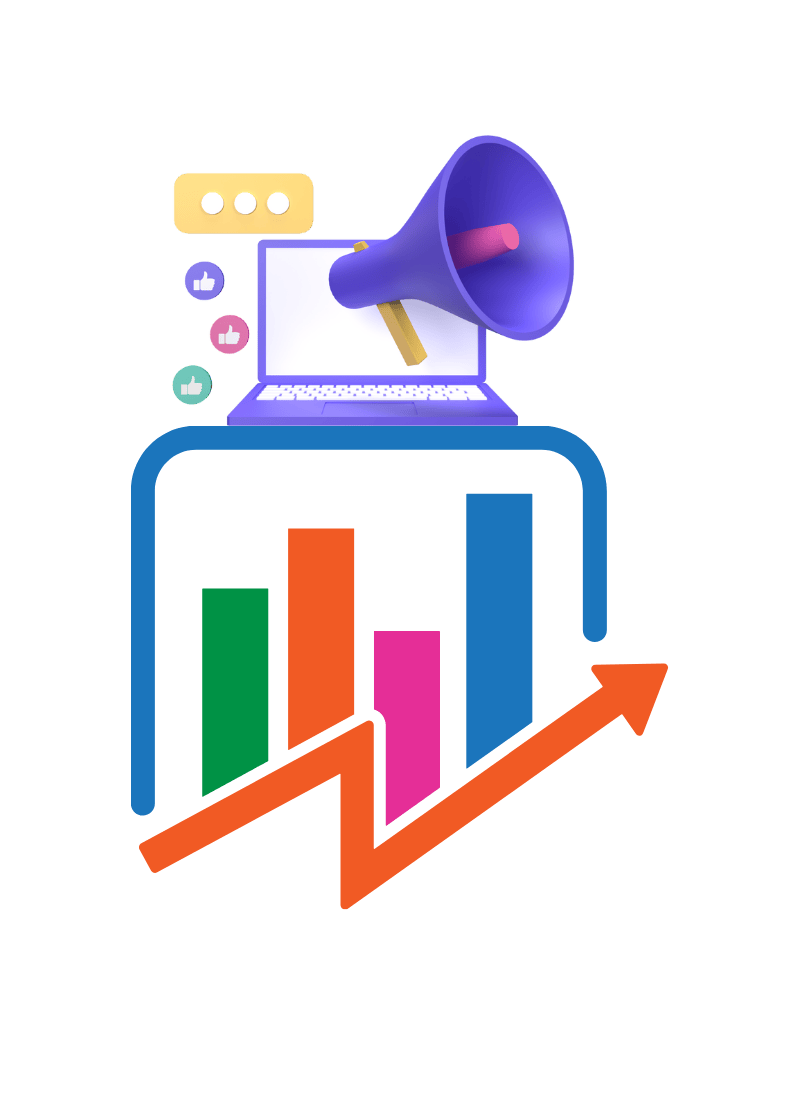The quick answer is that content marketing and SEO are complementary but distinct strategies. Content marketing focuses on creating valuable, relevant content to build relationships and engage your audience, while SEO (search engine optimization) focuses on optimizing that content and your website so it ranks higher in search engine results. In other words, content marketing draws people in with compelling information, whereas SEO helps those people find your content through search engines. Both are long-term strategies and often work hand-in-hand, but they have different goals and tactics.
In practice, content marketing could be a blog post, video, or social post that educates or entertains your target customers. SEO, on the other hand, involves things like keyword research, on-page optimization, link-building, and technical improvements to make that content visible to search engines. When combined, these strategies amplify each other: great content gives SEO material to optimize, and SEO drives more organic traffic to your content. As one expert notes, “content marketing is really any type of marketing that uses words to build trust with your audience… SEO strategy is way more technical… [it] focuses on keywords and content optimization with the hopes of being found at the top of search results pages”.
Figure: Content marketing and SEO form a virtuous cycle – content attracts and engages, while SEO drives traffic and insights. Source: 8-bit Content.
What Is Content Marketing?
Content marketing is a strategic approach to attracting and retaining customers by consistently creating and distributing valuable, relevant content. It’s about providing useful information (blog posts, videos, podcasts, e-books, social media posts, etc.) that educates or entertains your target audience. Content marketing is a long-term strategy built on trust: by delivering high-quality content, your brand establishes authority and keeps your audience coming back. As Neil Patel explains, “content marketing is a long-term strategy that focuses on building strong relationships with your target audience by consistently delivering high-quality, relevant content that educates and, ultimately, sells”.
For small businesses, content marketing might include a helpful how-to article on your blog, a series of engaging social media posts, or an email newsletter with industry tips. The goal is to provide value (not a hard sell) so that readers see your business as an expert resource. Effective content marketing builds brand awareness and trust, creating an audience that’s more likely to buy from you when they are ready. For example, the owner of Pet Sitters Ireland grew revenue by 450% over three years primarily through blogging three times a week and providing pet-care resources online. That content consistently answered pet owners’ questions, and over time it attracted customers and even franchise opportunities, all through valuable information rather than paid ads.
Key aspects of content marketing include:
- Audience focus: Content marketing is driven by audience needs and interests. You research what your customers want to learn and create content around those topics.
- Storytelling and authority: Good content often tells a story or offers insights that establish your brand as an authority. High-quality content must show expertise, be trustworthy, and provide value, so readers keep coming back.
- Variety of formats: Content marketing can use blogs, infographics, videos, social media, podcasts, and more. The format should match where your audience is (e.g. social media posts for younger audiences, long-form guides for complex topics).
While content marketing aims at audience engagement and trust, it often indirectly supports SEO. In fact, search engines “favor websites rich in quality content,” so consistently publishing content can improve SEO performance over time. But at its core, content marketing is about people: it answers customer questions and builds loyalty through meaningful content.

What Is SEO (Search Engine Optimization)?
Search Engine Optimization (SEO) is the set of techniques used to improve a website’s visibility and ranking on search engines like Google. The goal of SEO is to increase the quantity and quality of organic traffic (non-paid traffic) to your site. In simple terms, SEO makes your site easier for search engines to find and favor when users search for relevant keywords.
According to the Interaction Design Foundation, “SEO is the process of improving the visibility of a website or webpage on a search engine results page (SERP)… thereby driving traffic and sales”. More succinctly, Carter Carter defines SEO as “increasing the quantity and quality of traffic to a website by making it more easily discoverable to search engines and users”. This includes optimizing content, site structure, performance, and building links.
Key components of SEO include:
- Keywords: Identifying and using relevant keywords (words or phrases users search for) in your content, titles, and meta tags. Keyword research guides what topics to target so your site shows up for searches.
- On-page optimization: Ensuring each page has optimized meta titles, headings, image alt text, and content structure. This also means creating clear, engaging titles and breaking up text with headings (H2, H3) and visuals.
- Technical SEO: Improving site speed, mobile responsiveness, and crawlability. For example, fixing broken links, using structured data, and optimizing images help search engines index and rank pages.
- Off-page SEO (Backlinks): Earning high-quality backlinks from other websites signals to search engines that your site is authoritative. The more reputable sites linking to you, the higher your site can rank.
SEO is inherently technical. As SmartBug Media notes, “SEO strategy is way more technical than your content marketing strategy… It focuses on keywords and content optimization with the hopes of being found at the top of search engine results pages (SERPs)… SEO is more structured than content marketing”. In practice, SEO work might involve an SEO audit, using tools like Google Analytics and Search Console to track performance, and implementing ongoing tweaks to improve rankings.
One real-world example of SEO in action comes from Robben Media: a health insurance provider ranked #1 for “health insurance” and got 50,000 clicks/month from Google. With a modest 3% conversion rate, this translated into 1,500 new customers and roughly $2 million in monthly revenue. This illustrates that good SEO can produce substantial long-term returns. Another example: a marketing agency used SEO to double a client’s organic traffic in just two months, generating 150 new leads and multiple sales. These cases show how focusing on SEO – through content optimization and keyword strategy – can directly boost traffic and sales.
Key Differences: Content Marketing vs SEO
While content marketing and SEO overlap, they have different goals, scopes, and tactics. Understanding their differences helps small businesses prioritize efforts and deploy both strategies effectively. Below is a comparison of the two strategies in key areas:
| Aspect | Content Marketing | SEO (Search Engine Optimization) |
|---|---|---|
| Primary Goal | Build brand awareness, engage and retain audience, and drive leads through valuable content. | Improve website visibility and ranking on search engines to drive organic traffic. |
| Focus | Audience-first: Creating helpful content (blogs, videos, infographics) for users. | Search-first: Optimizing content and site technicalities to satisfy search engine algorithms. |
| Content Depth | Broader, story-driven, covering wide topics that interest audience. | Often keyword-driven, focusing on specific terms/questions (informational and transactional). |
| Technique | Storytelling, content planning, editorial calendar, diverse formats. | Keyword research, on-page optimization (titles, tags), link building, site structure fixes. |
| Timeframe | Long-term (brand-building); may take time to see ROI but yields lasting trust and loyalty. | Long-term (SEO is ongoing); some initial gains may appear in months, but full ROI can take longer. |
| Metrics | Engagement (time on page, shares, leads generated, brand lift). | Search rankings, organic traffic volume/quality, click-through rates from SERPs. |
| Success Story | Small business blog grew revenue 450% in 3 years. | Company doubled organic leads in 2 months with targeted SEO. |
The main point is: Content marketing builds the value; SEO increases the visibility of that value. Content marketing tends to be multi-channel (blogs, social, email), whereas SEO focuses specifically on search engines and your website.
- Audience vs Search Engine: Content marketing keeps the customer front and center. You create content for people’s interests and solve their problems. SEO is more technical, focusing on search bots and algorithms. It ensures search engines understand and favor your content. For example, you might write a detailed blog about a topic (content marketing) and then optimize it with targeted keywords, meta tags, and backlinks (SEO) so that readers can find it via Google.
- Structure and Process: As WebFX notes, “SEO is more structured than content marketing. SEO has steps you can follow… content marketing, on the other hand, is more subjective and doesn’t have a set way of being successful”. Indeed, SEO often follows checklists (keyword mapping, technical audit, link strategies), while content marketing relies on creativity and understanding audience preferences. Quality writing doesn’t have one right formula, but good SEO practices are more prescriptive.
- Immediate vs Compound Impact: SEO efforts (like optimizing a page or fixing site speed) may take time for search engines to index before you see traffic gains, but once achieved they can drive traffic steadily. Content marketing results often compound over time: each blog post or video adds to your brand’s presence and can continue to attract new leads for months or years. For instance, an evergreen blog post can keep bringing visitors long after it’s published. Both strategies require patience, but content marketing is often considered even longer-term since it’s about relationship-building.
- Metrics of Success: With content marketing, you might measure social shares, email sign-ups, time on page, and the number of leads generated from content campaigns. These indicate how well your content resonates with people. With SEO, you look at search rankings, increases in organic search traffic, and click-through rates (CTRs) from search results. Tools like Google Search Console and Google Analytics help track these metrics. Ultimately, both should feed into business goals (e.g. sales or sign-ups), but their intermediate metrics differ.
In summary, content marketing vs SEO isn’t an “either/or” choice – it’s more about emphasis. Small businesses should ideally integrate both: produce valuable content and optimize it for search. Think of it like this: Content marketing creates the catalyst (great articles, guides, etc.), while SEO ensures that catalyst reaches a wider audience by ranking well on Google.
How Content Marketing and SEO Work Together
Content and SEO actually amplify each other. High-quality content attracts backlinks and engagement, which boost SEO; conversely, SEO helps the right audience discover your content. As BuzzSumo explains, content marketing and SEO are “distinct but they each feed off each other to drive website traffic and visibility”. In practice, you might write an in-depth blog post (content marketing) because SEO research showed high search demand for that topic. Then you optimize that post’s keywords and meta tags (SEO) and promote it on social media (content marketing) to attract shares and links. This virtuous cycle leads to greater trust, visibility, and authority online.
Consider the 8-Bit Content diagram above: content marketing (on the left) provides a steady supply of articles, videos, etc., that “help you attract, engage & nurture leads.” SEO (on the right) then acts as “a potentially awesome source of traffic” to that content. The arrows between them highlight how content feeds SEO (giving it keywords and topics) and SEO feeds content (through data on what customers search for). This synergy means businesses don’t have to choose one over the other – the best results come from combining both strategies.
For example, a small online retailer might start a blog answering common customer questions. As they publish valuable content, they implement SEO best practices (using target keywords in their titles, creating descriptive URLs, and earning backlinks). Over time, Google starts ranking their articles for those customer questions. Website traffic grows without paid ads, and the engaging content on those pages converts visitors into buyers. The retailer is using content marketing to serve the audience and SEO to drive the audience to their site.
Another case: A software startup optimized its website and repurposed old blog posts based on keyword insights. By tweaking keywords and upgrading content, they saw a 100% increase in organic traffic and gained new leads within two months. Similarly, the American Egg Board improved SEO by adding fresh content and better site design, resulting in “higher organic search numbers and increased website visits”. These examples show that good content is the foundation, and SEO techniques amplify its reach.
Key Insights: When to Use Content Marketing vs. SEO
- Goal Clarity: If your priority is building brand awareness, trust, and engagement, focus on content marketing (blogs, social campaigns, video). If you need to improve your site’s visibility in search and quickly increase organic traffic, prioritize SEO tactics. Often, the biggest impact comes from doing both together.
- Long-term vs. Short-term: Remember, both strategies generally pay off over the long term. SEO results can take 4–6 months or more to materialize, while content marketing may take even longer to build momentum. However, content has the advantage of creating assets that keep working (evergreen posts, guides). Short-term gains are usually small unless you have a big paid push; real growth often requires consistent investment in both.
- Resource Allocation: Small businesses often have limited time and budget. Start by researching keywords to align content with what customers search for (a synergy of SEO & content strategy). Create a few cornerstone pieces of content that answer big customer questions. Optimize those pieces for SEO. As you grow, expand into social media and email to distribute content further.
- Measure Performance: Track the right metrics. For content, use engagement metrics and lead generation (are people downloading your guides? signing up for newsletters?). For SEO, watch organic search traffic and rankings for target keywords. You can also calculate ROI for content marketing to justify your efforts. (For guidance on this, see MarketingOWO’s guide on how to measure content marketing ROI.)
- Examples for Inspiration: Look at success stories in your industry. Many brands (from small local shops to big SaaS firms) have grown by blogging regularly and optimizing content. For instance, Jerome’s Furniture (a local retailer) improved its site’s content and added downloadable guides, which boosted traffic and reduced ad spend. On the SEO side, companies that target high-intent keywords on their service pages often see steady lead flow without extra advertising.
- Integration is Key: Ultimately, don’t think of content marketing vs SEO as a contest. A smart marketing strategy integrates them. Quality content fuels SEO, and SEO ensures your content finds the right audience. As Webtune observes, “successful marketing campaigns intertwine the principles of both SEO and Content Marketing to maximize reach and conversion rates”.
By keeping these insights in mind, small business owners and content creators can balance their efforts effectively. Good content provides lasting value to customers, while SEO helps that content get found. Both are essential pillars of digital marketing.
Conclusion
Content marketing and SEO each play unique roles in a digital strategy. Content marketing is about what you say to your audience – educating, entertaining, and building trust through stories and resources. SEO is about making sure people hear you – optimizing your website and content so it ranks higher and attracts clicks. Used together, they form a powerful engine for growth.
Small businesses should focus on creating audience-centered content first, and then apply SEO best practices to increase visibility. Over time, this leads to a virtuous cycle of traffic, trust, and conversions. As one blog sums it up: “the ideal digital marketing strategy includes both content marketing and SEO”.
Now that you understand the key differences and interplay between content marketing vs SEO, consider how you can apply both to your business. Which strategy will you prioritize first, and how will you integrate them? Share your thoughts and experiences in the comments below. If you found this post helpful, please share it with your network or on social media. And don’t miss other resources on MarketingOWO – for example, check out our guide on how to measure content marketing ROI to see the tangible impact of your content investments.
Together, content marketing and SEO can help your business climb higher – one well-optimized blog post at a time. We look forward to hearing how you use these strategies to grow.




